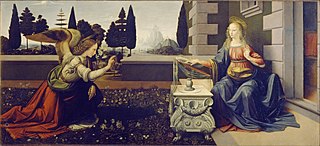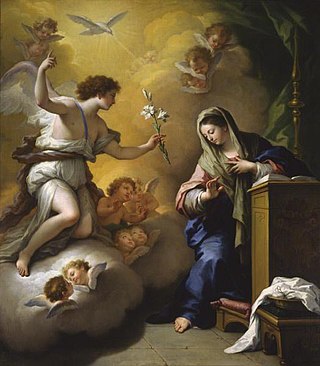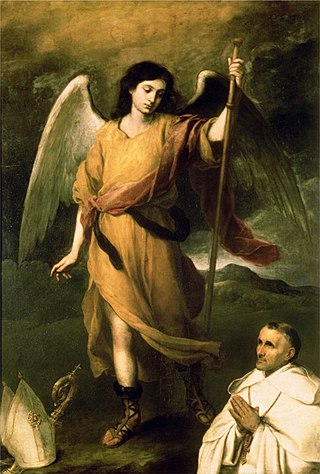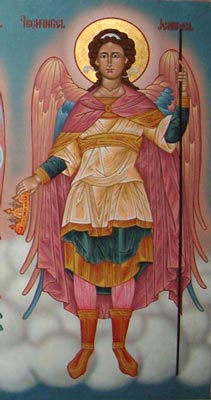The deuterocanonical books, meaning "Of, pertaining to, or constituting a second canon," collectively known as the Deuterocanon (DC), are certain books and passages considered to be canonical books of the Old Testament by the Catholic Church, the Eastern Orthodox Church, the Oriental Orthodox Churches and the Assyrian Church of the East, but which modern Jews and Protestants regard as apocrypha.

Michaelmas is a Christian festival observed in many Western Christian liturgical calendars on 29 September, and on 8 November in the Eastern Christian traditions. Michaelmas has been one of the four quarter days of the English and Irish financial, judicial, and academic year.

In the Abrahamic religions, Gabriel is an archangel with the power to announce God's will to mankind. He is mentioned in the Hebrew Bible, the New Testament, the Quran and the Kitáb-i-Aqdas. Many Christian traditions – including Eastern Orthodoxy, Catholicism, Lutheranism, and Anglicanism – revere Gabriel as a saint.

Archangels are the second-lowest rank of angel in the Christian hierarchy of angels, put forward by Pseudo-Dionysius the Areopagite in the 5th or 6th century in his book De Coelesti Hierarchia. The word "archangel" itself is usually associated with the Abrahamic religions, but beings that are very similar to archangels are found in a number of other religious traditions.

The Book of Tobit, also known as the Book of Tobias, is a 3rd or early 2nd century BC work describing how God tests the faithful, responds to prayers, and protects the covenant community. It tells the story of two Israelite families, that of the blind Tobit in Nineveh and of the abandoned Sarah in Ecbatana. Tobit's son Tobias is sent to retrieve ten silver talents that Tobit once left in Rages, a town in Media; guided and aided by the angel Raphael he arrives in Ecbatana, where he meets Sarah. A demon named Asmodeus has fallen in love with her and kills anyone she intends to marry, but with the aid of Raphael the demon is exorcised and Tobias and Sarah marry, after which they return to Nineveh, where Tobit is cured of his blindness.
Many Wikipedia articles on religious topics are not yet listed on this page. If you cannot find the topic you are interested in on this page, it still may already exist; you can try to find it using the "Search" box. If you find that it exists, you can edit this page to add a link to it.

Raphael is an archangel first mentioned in the Book of Tobit and in 1 Enoch, both estimated to date from between the 3rd and 2nd century BCE. In later Jewish tradition, he became identified as one of the three heavenly visitors entertained by Abraham at the Oak of Mamre. He is not named in either the New Testament or the Quran, but later Christian tradition identified him with healing and as the angel who stirred waters in the Pool of Bethesda in John 5:2–4, and in Islam, where his name is Israfil, he is understood to be the unnamed angel of Quran 6:73, standing eternally with a trumpet to his lips, ready to announce the Day of Judgment. In Gnostic tradition, Raphael is represented on the Ophite Diagram.

Michael, also called Saint Michael the Archangel, Archangel Michael and Saint Michael the Taxiarch is an archangel in Judaism, Christianity, Islam, and the Baha'i faith. The earliest surviving mentions of his name are in third- and second-century-BC Jewish works, often but not always apocalyptic, where he is the chief of the angels and archangels, and he is the guardian prince of Israel and is responsible for the care of Israel. Christianity conserved nearly all the Jewish traditions concerning him, and he is mentioned explicitly in Revelation 12:7–12, where he does battle with Satan, and in the Epistle of Jude, where the author denounces heretics by contrasting them with Michael.

In Christianity, angels are the messengers of God.

Uriel, Auriel or Oriel is the name of one of the archangels who is mentioned in the post-exilic rabbinic tradition and in certain Christian traditions. He is well known in the Russian Orthodox tradition and in folk Catholicism and recognised in the Anglican Church as the fourth archangel. He is also well known in European esoteric medieval literature. Uriel is also known as a master of knowledge and archangel of wisdom.
Sariel is an angel mainly from Judaic tradition. Other possible versions of his name are Suriel, Suriyel, Seriel, Sauriel, Saraqael, Sarakiel, Suruel, Surufel, and Souriel.

The Hebrew name Jerahmeel, which appears several times in the Tanakh, also appears in various forms as the name of an archangel in books of the intertestamental and early Christian periods.
Ramiel is a fallen Watcher (angel). He is mentioned in Chapter 7 of the apocryphal Book of Enoch as one of the 20 Watchers that sinned and rebelled against God by mating with human women, and creating offspring called Nephilim.

Jegudiel, also known as Saint Iehudiel, is one of the seven Archangels in Eastern Orthodox tradition.

In the Bible, the term Seven Spirits of God appears four times in the Book of Revelation. The meaning of this term has been interpreted in multiple ways.
In some Judeo-Christian traditions, the Angel of the Presence / Face or Angel of his presence / face refers to an entity variously considered angelic or else identified with God himself.

Saint Michael the Archangel is referenced in the Old Testament and has been part of Christian teachings since the earliest times. In Catholic writings and traditions he acts as the defender of the Church and chief opponent of Satan, and assists people at the hour of death.
A biblical canon is a set of texts which a particular Jewish or Christian religious community regards as part of the Bible.
Articles related to Christianity include:
















